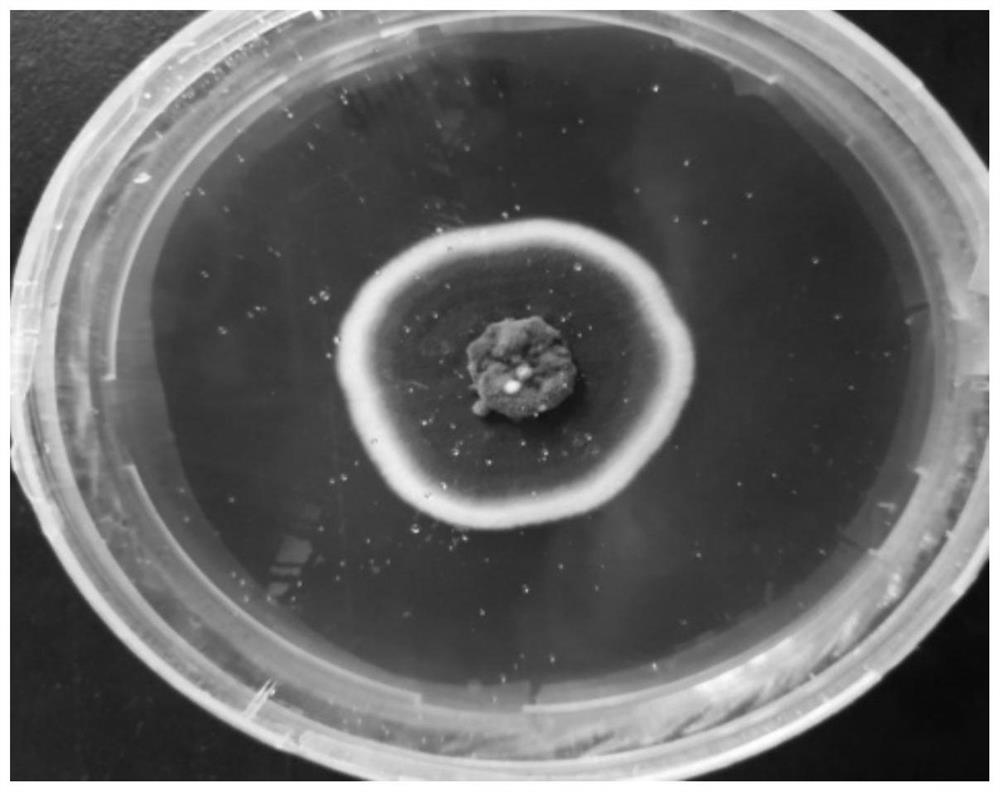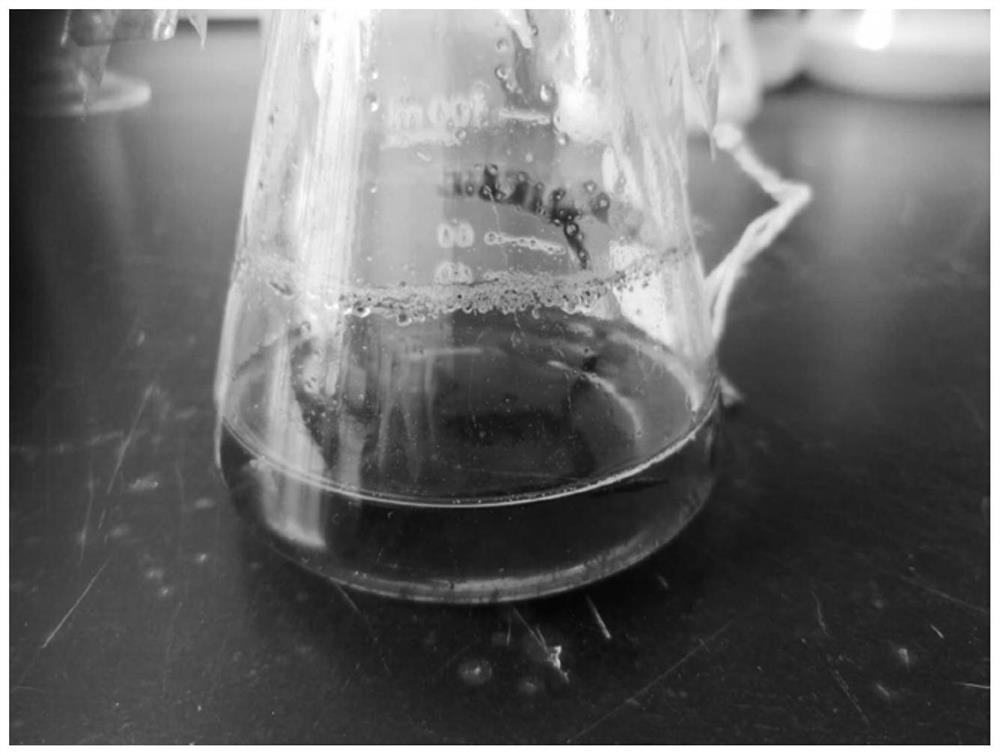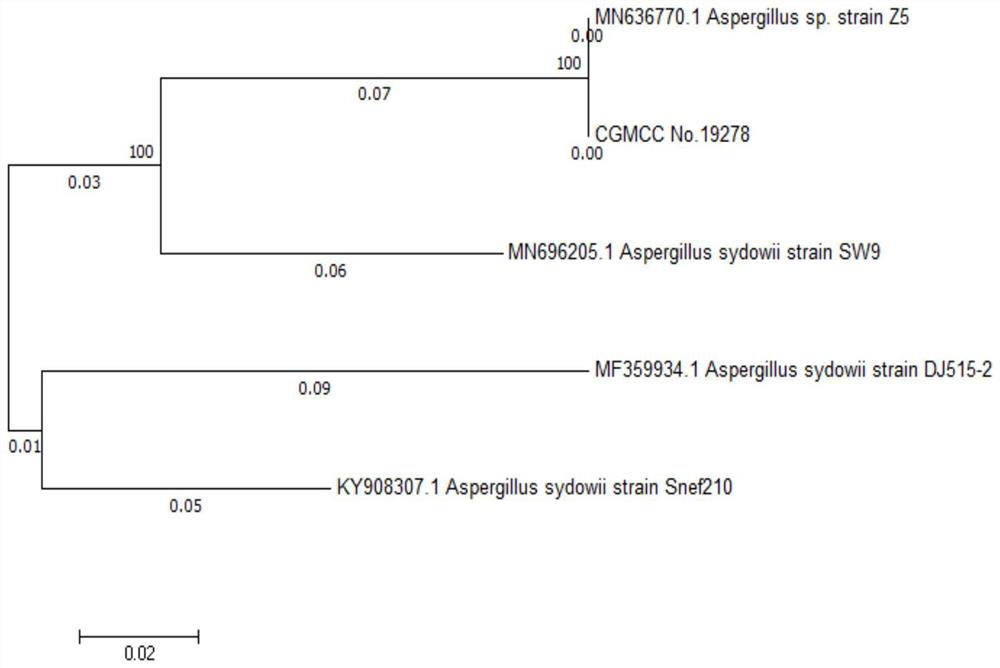Aspergillus sydowii and application thereof in promoting plant growth and preventing and treating plant diseases
A technology of Aspergillus polypolyps and plants, which can be used in plant growth regulators, plant growth regulators, pest control, etc., and can solve the problem of poor cold resistance, drought resistance and strong light radiation, which restricts the development of the artificial planting industry of heavy buildings , Artificial planting is difficult and other problems, to achieve strong inhibitory effect, increase plant chlorophyll content, improve the effect of abiotic stress resistance
- Summary
- Abstract
- Description
- Claims
- Application Information
AI Technical Summary
Problems solved by technology
Method used
Image
Examples
Embodiment 1
[0036] Embodiment one, strain isolation
[0037] (1) Rinse the harvested Huazhonglou seeds with running water for 10 minutes, blot the surface moisture with filter paper, soak in 75% ethanol for 30 seconds, rinse with sterile water 2 to 3 times, and then disinfect the surface with 0.2% mercury chloride for 10 minutes , washed with sterile water for 3 to 4 times, and 100 μL of sterile water from the final rinse was applied to the tiger bengal solid medium as a control.
[0038] (2) Cut the surface-sterilized Huazhonglou seeds into small pieces with a sterilized blade, place them in a mortar sterilized by high-temperature dry heat at 200°C, add 10 mL of sterile saline, and grind them thoroughly.
[0039] (3) Take 100 μL of the above liquid, repeat 3 times, spread it on a solid tiger bengal plate, and culture it in the dark at 28°C, and different fungi will grow for about 10 days.
[0040] (4) Pick a little hyphae and repeatedly purify them for 4 to 6 generations on a PDA plate,...
Embodiment 2
[0042] Embodiment two, bacterial strain identification
[0043] Inoculate the above strains into liquid PDB medium, culture at 28°C and 200rpm for 5 to 7 days, collect the bacteria by centrifugation at 4°C and 8000rpm, and after the tissue disruptor is fully broken, use the SDS method to extract genomic DNA. PCR amplification. Primers are:
[0044] ITS1: 5'-TCCGTAGGTGAACCTGCGG-3'
[0045] ITS4: 5'-TCCTCCGCTTATTGATATGC-3'
[0046] The PCR reaction system is 50μl: Buffer (Mg2+plus) 10μl, forward and reverse primers 2μl each, dNTP Mixture (each 2.5mM) 4μl, HS DNA Polymerase (2.5Μ / μl) 0.5μl, DNA template 1μl, ddH2O 31.5μl.
[0047] PCR amplification conditions: denaturation at 98°C for 10 sec, annealing at 56°C for 15 sec, extension at 72°C for 1 min and 30 sec, 30 cycles, and extension at 72°C for 5 min.
[0048] The amplified products were sent to Beijing Qingke Xinye Biotechnology Co., Ltd. for sequencing. The sequencing results were compared in the NCBI database blast...
Embodiment 3
[0052] Embodiment 3, qualitative detection of nitrogen fixation and phosphorus solubilization activity of Aspergillus polypolyphaga JDQMZZ-1
[0053] Qualitative detection of nitrogen fixation activity: Prepare Ashubei medium, add 0.5% Congo red 5ml / L, sterilize and make a plate for use, pick a small amount of mycelia from the edge of the preserved Aspergillus polydoctoris JDQMZZ-1 colony and inoculate on the above Cultivate in the Ashubei culture medium at 28°C for 7 days in the dark, and observe the growth of the colonies.
[0054] Congo red is a brown-red powder, which is yellow-red when dissolved in water, and orange when dissolved in alcohol. It is used as an acid-base indicator with a color change range of 3.5 to 5.2. , shown as a red circle. The size of the circle and the depth of the color can reflect the strength of nitrogen fixation ability to a certain extent.
[0055] Qualitative detection of phosphorus-solubilizing ability: inoculate Aspergillus polypolyphagum J...
PUM
 Login to View More
Login to View More Abstract
Description
Claims
Application Information
 Login to View More
Login to View More - R&D
- Intellectual Property
- Life Sciences
- Materials
- Tech Scout
- Unparalleled Data Quality
- Higher Quality Content
- 60% Fewer Hallucinations
Browse by: Latest US Patents, China's latest patents, Technical Efficacy Thesaurus, Application Domain, Technology Topic, Popular Technical Reports.
© 2025 PatSnap. All rights reserved.Legal|Privacy policy|Modern Slavery Act Transparency Statement|Sitemap|About US| Contact US: help@patsnap.com



